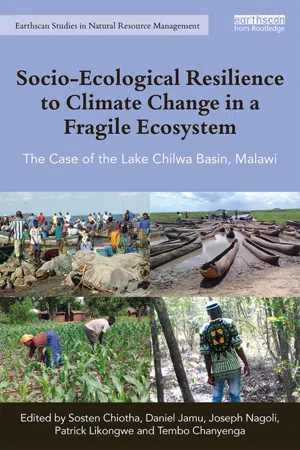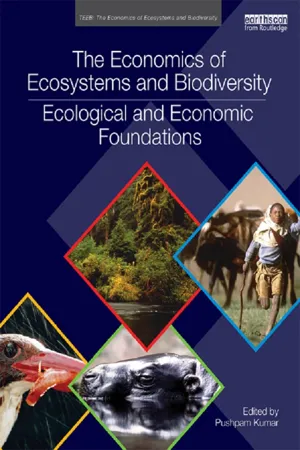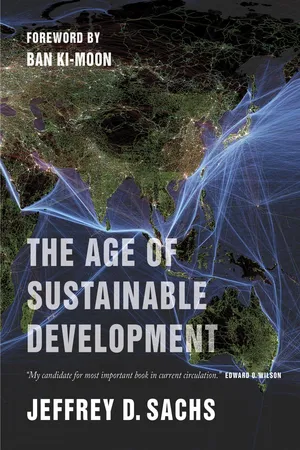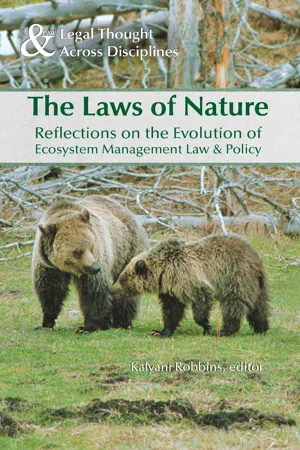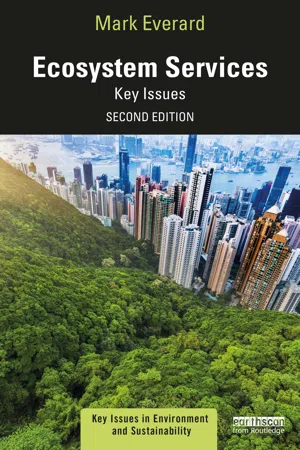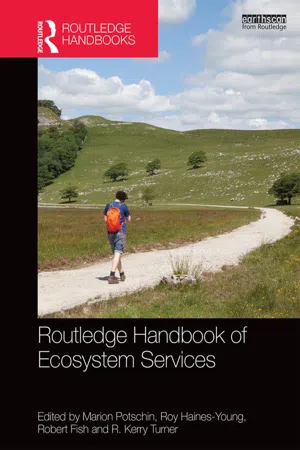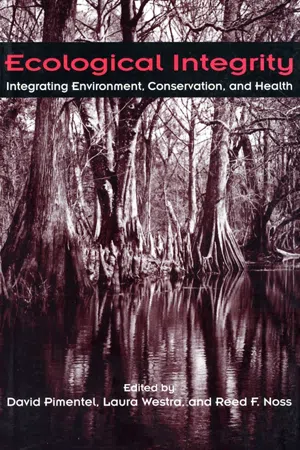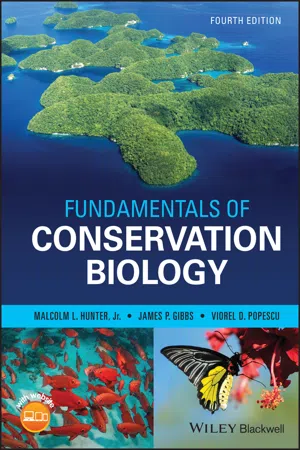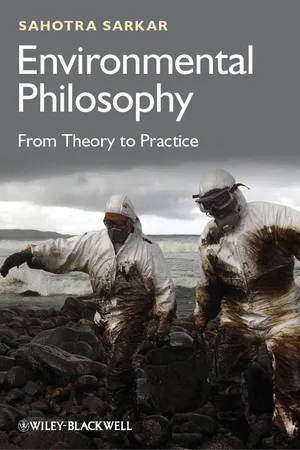Biological Sciences
Protecting Ecosystems
Protecting ecosystems involves preserving the delicate balance of living organisms and their environment. This includes safeguarding biodiversity, maintaining natural habitats, and preventing the degradation of ecosystems. Conservation efforts aim to minimize human impact, promote sustainable practices, and ensure the long-term health and stability of ecosystems.
Written by Perlego with AI-assistance
Related key terms
Related key terms
1 of 4
Related key terms
1 of 3
10 Key excerpts on "Protecting Ecosystems"
- eBook - ePub
Socio-Ecological Resilience to Climate Change in a Fragile Ecosystem
The Case of the Lake Chilwa Basin, Malawi
- Sosten Chiotha, Daniel Jamu, Joseph Nagoli, Patrick Likongwe, Tembo Chanyenga(Authors)
- 2018(Publication Date)
- Routledge(Publisher)
The ecosystem approach (EA) is a subset of ecosystem management which attempts to integrate sustainable ecological, economic and social goals in a unified, systems approach. Ecosystem management recognizes that humans cannot have a sustained progress towards social goals in a deteriorating environment or economy, and vice versa (Cunningham and Cunningham 2010). Ecosystem managers should be advised to adopt adaptive management, expecting, accommodating and managing for change rather than obstructing it. Further, ecosystem managers should evaluate probabilities and risks using the “precautionary principles” where management decisions should have a safety factor to allow that knowledge is limited and institutions are imperfect and finally learn the possible and elaborate techniques to bring about effective ecosystem restoration (Maltby et al. 1999). Some of the principles of ecosystem management that complement and work in unison with the ecosystem approach are:The main goals of ecosystem management, among others, are to:• Managing across landscapes;• Considering human needs and promoting economic development and communities;• Maintaining biological diversity and essential ecosystem services;• Utilizing cooperative institutional arrangements;• Generating meaningful stakeholder and public involvement and facilitating collective decision making;• Adapting management over time, based on conscious experimentation and routine monitoring.Ecosystems and Ecosystem Services (ES)• Maintain viable populations of native species in situ;• Represent, within protected areas, all native ecosystem types across their range of variation;• Protect essential ecological processes such as nutrient cycles, succession, hydrological processes, etc.;• Manage over long periods of time to sustain the evolutionary potential of species and ecosystems; and• Accommodate human use and occupancy within these constraints (Cunningham et al. 2005).The CBD defines an ‘ecosystem’ as “a dynamic complex of plant, animal and micro-organism communities and their non-living environment interacting as a functional unit.” The term can refer to any functioning unit at any scale. The scale of analysis should be determined by the problem being addressed, thus an ecosystem can be a grain of soil, a pond, a forest, a biome or the entire biosphere. The ecosystem includes living organisms and the abiotic environment which they inhabit and interact with. Ecosystems are dynamic; their structure and function change with time. As components of ecosystems, humans and their interactions have profound effects on the structure and function of ecosystems. A healthy ecosystem is one which is active, maintains its organization and is resilient to stress over time. The health of ecosystems is not only essential to the environment, but also important to the existence and development of the human society. - Pushpam Kumar(Author)
- 2012(Publication Date)
- Routledge(Publisher)
Section 5.1.1 ), can be applied at landscape or regional scales, and can generate significant economic savings. An example is given by the integrated programmes seeking to restore degraded natural systems and rehabilitate production systems in the Drakensberg Mountain Range Project (Blignaut et al, 2008).7 Conclusions and further researchWe now have a reasonable understanding of the intricacies and outcomes of ecological dynamics as well as the expressions of these processes in the provision of goods and services to human society. Significant gaps in our knowledge remain, but there is an emerging scientific consensus on the need to sustain biological diversity to protect the delivery of ecosystem services. Nevertheless, if we wish, for example, to predict the impact of biodiversity change on variability in the supply of ecosystem services, we need to measure the impact of biodiversity conservation over a range of environmental conditions. In the same way, we need to be able to identify the effect of biodiversity change on the capacity of social-ecological systems to absorb anthropogenic and environmental stresses and shocks without loss of value (Scheffer et al, 2000; Kinzig et al, 2006; see Figure 2.8 ). To do so requires comprehensive analysis of the myriad linkages among biodiversity change, ecological functioning, ecosystem processes and the provision of valued goods and services. To understand or enhance the resilience of such complex, coupled systems, therefore, would need robust models of every link between biodiversity and ecosystem services, and between biodiversity change and human well-being (Perrings, 2007).A major gap in knowledge is how different ecosystems interact in the delivery of services. Ecosystems are rarely homogeneous. For example, extensive forest ecosystems often contain rivers, lakes and wetlands as well as patches of land which may be farmed or managed as open habitat for wildlife. It is important to know how the various combinations of ecosystems operate together to generate services, which may be enhanced or impeded by interactions. Equally we need urgently to develop evidence-based management practices that maximize the delivery of a broad range of services from individual ecosystems, especially where these are managed intensively for food or fuel.- eBook - ePub
- Jeffrey D. Sachs(Author)
- 2015(Publication Date)
- Columbia University Press(Publisher)
As is true of everything in sustainable development, we are dealing with a complex system, where there is not a linear effect from a single cause to a single outcome and then on to another effect. There are multiple stressors, multiple drivers of environmental change, and multiple causes of species extinction and the decline in species abundance and genetic diversity. We must understand the complexity of this system, because no single approach will be sufficient to head off this sixth great extinction that threatens millions of species, including Homo sapiens —human beings, ourselves! To understand biodiversity we must start with an understanding of an ecosystem —the collection of plants, animals, and microbial life interacting with the abiotic (nonliving) part of the local environment. The key is that this is a set of living organisms and the nonliving environment, that all interact in a system. Ecologists study ecosystems by studying the fluxes and dynamics of the system—how does nutrient flow take place within a food web and within the processes of metabolism, oxidation, respiration, photosynthesis, and other basic processes of metabolism in the living organisms within the system? How does the diversity of the species, and the diversity of the individual organisms within a species, affect the behavior of that whole ecosystem? Another core concept of an ecosystem is its biological diversity, or biodiversity. Biodiversity is the variability of life that occurs at all different levels of organization. Biodiversity includes the variability of life within a species—each of us is different from other people, with variations in our genetic makeup. Biodiversity also includes the diversity of species within an ecosystem and the various relationships of the species, such as predator and prey, mutualism and parasitism - eBook - ePub
The Laws of Nature
Reflections on the Evolution of Ecosystem Management Law & Policy
- Kalyani Robbins(Author)
- 2013(Publication Date)
- University of Akron Press(Publisher)
The spatial definition of an ecosystem is any unit of nature, at any scale, in which the biotic organisms and abiotic environment interact in a manner that results in an ongoing and dynamic biotic structure. 4 However, some adhere to a more ‘process-based’ view, in which an ecosystem is defined by the processes through which it functions, such as “productivity, energy flow among trophic levels, decomposition, and nutrient cycling.” 5 Regardless of the ecosystem understanding one prefers, there is no question that ecosystems provide humans with many essential services, some of which are even subject to economic valuation via a replacement-cost analysis. 6 The phrase ‘ecosystem management’ already gives away quite a bit, if we simply look at the combination of terms. The term ‘ecosystem’ evokes nature. An ecosystem is the most fundamental unit in nature, and the relationships it embodies are essential to understanding our natural world. Arthur Tansley, a pioneer of the science of ecology, coined the term ‘ecosystem’ in 1935. Tansley stated: “Though the organisms may claim our prime interest, when we are trying to think fundamentally, we cannot separate them from their special environments, with which they form one physical system.” 7 ‘Management,’ on the other hand, suggests human control. It is a very unnatural word, the opposite of letting nature take its course. Indeed, in spite of the fact that the Clinton administration introduced the ecosystem management concept in an effort to incorporate scientific principles into the management of the national forests (recognizing that ecosystems were the focus for scientists), 8 the initial effort involved such excessive top-down government control that it met with great resistance. 9 The concept later evolved into one involving greater shared decision making at multiple levels, 10 though management is still management, a human domination over nature - eBook - ePub
Ecosystem Services
Key Issues
- Mark Everard(Author)
- 2021(Publication Date)
- Routledge(Publisher)
The relative contributions of different components of ecosystems and their interactions to the production of services vary between ecosystem services, as too does our level of understanding about exactly how these services are produced. Present-day usage of the term ‘ecosystem’ tends to include a broader set of environmental, economic, social, political and humanities science than implied by earlier definitions based purely on the natural world, acknowledging that people are part of an interactive holistic (socio-economic) system, where the welfare of humans and the health of the natural world are co-dependent (Raffaelli and White, 2013 ; Mace, 2014). Some ecosystem services derive directly from living elements. Biodiversity, shorthand for ‘biological diversity’, comprises ‘… the variability among living organisms from all sources including, inter alia, terrestrial, marine and other aquatic ecosystems and the ecological complexes of which they are part; this includes diversity within species, between species and of ecosystems’ (Convention on Biological Diversity, n.d.). Biodiversity is of central importance for the production of ecosystem services such as food, fibre, many ornamental resources, traditional herbal medicine and biologically based fuels, photosynthetic productivity and oxygen generation, nutrient cycling and soil formation, although uncertainties increase along this sequence as to precisely how these services are produced. Geodiversity, comprising ‘… the variety of rocks, fossils, minerals, natural processes, landforms and soils that underlie and determine the character of our landscape and environment’ (UKGAP, n.d.), plays crucial, albeit often indirect, supporting roles to these mainly biodiversity-derived service s. Other services are more directly dependent on geodiversity - eBook - ePub
Bioregional Planning
Resource Management Beyond the New Millennium
- D J Brunckhorst(Author)
- 2013(Publication Date)
- Routledge(Publisher)
The future is open to change. But what kind of future do we want? Clearly one that is healthy and sustained ecologically, socially and economically without imposing future costs on future generations. To actively pursue a sustainable future that will extend beyond the new millennium, we need to elaborate a vision owned by all sectors of local and regional communities. We then need to develop and implement various strategies to realise that vision within an appropriate spatial and temporal context. Good systems-based planning matches nature's functions with social functions to provide the objectives, strategies, actions and indicators to guide us towards a sustainable future and monitor our progress along the way. A bioregional framework can provide the required strategic context for action.HUMAN SOCIETY AND THE BIOSPHERE
To achieve a sustainable society while maintaining biodiversity is one of the great challenges of our time. Sustaining ecological processes to support society's production needs and aspirations for quality of life would seem to be both utterly impossible and absolutely necessary. Add to this paradox the fact that nature is in retreat — under enormous pressure from human exploitation and population growth. The complex, entwined interdependence of all creatures and the products of these interrelationships mean that ultimately human society is also threatened. Maintaining biodiversity and ecological processes is critically important to the future of human kind.Decisive actions are needed. Cooperative, on-ground, public-private facilitated actions are required for a sustainable future. Such models are more likely to be successful if they are able to express the magnitude of social, cultural, economic and biological needs of society, and if they are based on the best available scientific understanding. (Gunderson et al. 1995, Stienitz et al. - eBook - ePub
- Marion Potschin, Roy Haines-Young, Robert Fish, R. Kerry Turner(Authors)
- 2016(Publication Date)
- Routledge(Publisher)
To ensure that these linkages can be effectively assessed and understood, and to enable science to be translated into effective policy, continued effort is required to facilitate co-operation between the health and biodiversity / ecosystem services sectors, as well as other relevant sectors such as agriculture, tourism, trade, and economics, and with businesses and civil society. New approaches and initiatives continue to be developed to help foster these partnerships, based upon ecosystem approaches to health that view the conservation and sustainable use of biodiversity as being critical to protecting and enhancing the health of human communities.In as much as the loss of biodiversity can threaten the health of human populations, its conservation, restoration, and sustainable use can help to strengthen modern and traditional healthcare systems, protect against natural disasters, combat poverty and hunger, prevent disease outbreaks, and promote resilience, stability and security for millions of people worldwide. In this context, biodiversity and ecosystem services may be particularly important to reducing, or adapting to, the impacts of climate change. In many regions, critical health services provided by biodiversity – the provision of fresh water and clean air, the regulation of the global climate, the provision of food resources, and the regulation of pests and diseases – are under particular threat. Thus it becomes increasingly important not only to protect remaining ecosystems, but also to restore and enhance degraded ecosystems throughout the world.Notes
- 1 Convention on Biological Diversity (CBD) Article 2. Available at https://www.cbd.int/convention/text
- eBook - ePub
Ecological Integrity
Integrating Environment, Conservation, and Health
- David Pimentel, Laura Westra, Reed F. Noss, David Pimentel, Laura Westra, Reed F. Noss(Authors)
- 2013(Publication Date)
- Island Press(Publisher)
Despite––or perhaps because of––the simplicity and the breadth of this concept, the intellectual literature is rife with arguments over whether it is appropriate to speak of “ecological health” (Meyer 1997, Rapport et al. 1998a, Callicott et al. 1999, Goldstein 1999, Karr 1999).These arguments––with refinements based on theoretical, philosophical, scientific, ethical, and moral foundations––will likely continue forever. Regardless of the conclusions, the plain fact is that humans must grapple with the reality of environmental deterioration. At its core, this deterioration means a loss of life, the removal of bio- from the biosphere. It means the loss of the whole things that have nurtured all life, including humans.In my view, health as a word and concept in ecology is useful precisely because it is a familiar concept. It is an effortless intuitive step from “my health” to “ecological health.” Granted that we must operationalize the term––define it and find ways to measure it. But as a policy goal, protecting health––whether of landscapes, rivers, children, or wildlife––has a fighting chance of engaging public interest and support.What Is Integrity?
Protecting biological or ecological integrity is the core principle of national laws and international agreements in North America, Europe, and elsewhere (e.g., the U.S. Clean Water Act, Canada’s National Park Act, the Great Lakes Water Quality Agreement between the United States and Canada, and water policy directives being developed by the European Community). Like health, this term too needs to be operationalized. And it can be. When properly defined, integrity can serve as a benchmark of biological condition to clarify and understand humans’ relationship with their surroundings.Biological integrity refers to the condition of places at one end of a continuum of human influence, places that support a biota that is the product of evolutionary and biogeographic processes with little or no influence from industrial society (Figure 12.1 - eBook - ePub
- Malcolm L. Hunter, James P. Gibbs, Viorel D. Popescu(Authors)
- 2021(Publication Date)
- Wiley-Blackwell(Publisher)
2001 ; W. Duckworth, personal communication; Montesino Pouzols et al. 2014; van Breugel et al. 2015). In addition to identifying priority areas for conservation, such data‐rich gap analyses can provide information that supports more effective implementation and management of conservation strategies (Montesino Pouzols et al. 2014; van Breugel et al. 2015).Based on a previous box by: Eleanor J. Sterling, Martha M. Hurley, Andrew Tordoff, and Jonathan C. Eames.1Center for Biodiversity and Conservation, American Museum of Natural History.Summary
Often the most reliable way to conserve the biodiversity of ecosystems is to protect them in a reserve (also known as a park, refuge, sanctuary, protected area, etc.). The first step is to select reserves that will protect a large number of targeted species and/or a representative array of ecosystems, and this is likely to involve filling in the gaps in an existing reserve network by selecting new reserves that complement existing ones. Logistical considerations such as the degree of threat, current condition, and feasibility will also affect selection decisions. Designing reserves chiefly involves deciding on their size, shape, and location with respect to other types of ecosystems; it is particularly desirable that they sit in a landscape context that connects them to other reserves and buffers them from threats. Managing reserves to maintain their natural structure and function often will require controlling human visitors, exotic species (and sometimes overabundant native species), water distribution, and natural disturbance regimes, notably fires.FURTHER READING
For a grand overview on protecting and managing ecosystems see Groves (2003 ) and Groves and Game (2016 ) for an even broader treatment of conservation planning. Margules and Sarkar (2007 ) and Moilanen et al. (2009) provide insightful overviews of principles and methodologies of systematic conservation planning. For regional perspectives see Lindenmayer and Burgman (2005 ) for Australia, Noss and Cooperrider (1994 ) for North America, and Sutherland and Hill (1995 ) for Europe. See www.unep‐wcmc.org for an overview of the World Conservation Monitoring Centre’s work and particularly www.protectedplanet.net - eBook - ePub
Environmental Philosophy
From Theory to Practice
- Sahotra Sarkar(Author)
- 2011(Publication Date)
- Wiley-Blackwell(Publisher)
Let us return to the fundamental question: what is biodiversity? Even a cursory survey of professional papers or textbooks of conservation biology will reveal two canonical definitions; they will also reveal almost no research that uses these definitions. The canonical definitions are the following:1. Biodiversity refers to the variety of life at every level of structural, taxonomic, and functional organization.2. Biodiversity refers to diversity of genes (alleles), species, and ecosystems.Many conservation biologists, especially in moments of unbridled political advocacy, may endorse definition (1) but, if the term “biodiversity” is to reflect the practice of conservation biology, this definition is useless. Biodiversity, as Takacs has pointed out, becomes all of biology.24 It is absurd to think that we should—let alone that we can—protect all diversity of structure, taxonomy, and function. We would have to protect almost every biotic entity. Biodiversity conservation is not the only policy goal in any social context, and resources for it are obviously not unlimited. Consequently, biotic features must be prioritized and an adequate definition of “biodiversity” must reflect where a society's priorities lie with respect to the type of biological diversity that deserves the most attention. We cannot reasonably aim to protect every biotic entity, even in principle.Definition (2) was probably never intended to define “biodiversity” fully; rather, it was supposed to operationalize it in the sense that protecting these three categories would presumably protect most of what is intended to be captured by definition (1). The trouble is that it has been a rather unsuccessful operationalization: allelic diversity is almost impossible to estimate accurately or protect in natural populations; species diversity, if we really mean all species, including microbial species, is almost as intractable.In practice, conservation biologists work with either limited sets of taxa or ecosystem types (for instance, vegetation types). However, it is often unclear whether the choice of limited sets of taxa or ecosystem types is motivated by practical considerations of measuring biodiversity or whether it reflects what biodiversity is categorically supposed to be. It is important to introduce a critical distinction at this state:
Index pages curate the most relevant extracts from our library of academic textbooks. They’ve been created using an in-house natural language model (NLM), each adding context and meaning to key research topics.
Explore more topic indexes
Explore more topic indexes
1 of 6
Explore more topic indexes
1 of 4
